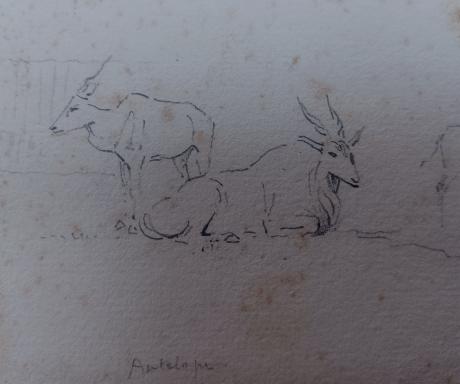inscribed
The term antelope refers to numerous extant or recently extinct species of the ruminant artiodactyl family Bovidae that are indigenous to most of Africa, India, the Middle East, Central Asia, and a small area of Eastern Europe. Antelopes do not form a monophyletic group, as some antelopes are more closely related to other bovid groups, such as bovines, goats, and sheep, than to other antelopes.
A stricter grouping, known as the true antelopes, includes only the genera Gazella, Nanger, Eudorcas, and Antilope. One North American mammal, the pronghorn or "pronghorn antelope", is colloquially referred to as the "American antelope", despite the fact that it belongs to a completely different family (Antilocapridae) than the true Old-World antelopes; pronghorn are the sole extant member of an extinct prehistoric lineage that once included many unique species.
Although antelope are sometimes referred to, and easily misidentified as, "deer" (cervids), true deer are only distant relatives of antelopes. While antelope are found in abundance in Africa, only one deer species is found on the continent—the Barbary red deer of Northern Africa. By comparison, numerous deer species are usually found in regions of the world with fewer or no antelope species present, such as throughout Southeast Asia, Europe and all of the Americas. This is likely due to competition over shared resources, as deer and antelope fill a virtually identical ecological niche in their respective habitats. Countries like India, however, have large populations of endemic deer and antelope, with the different species generally keeping to their own "niches" with minimal overlap.
Unlike deer, in which the males sport elaborate head antlers that are shed and regrown annually, antelope horns are bone and grow steadily, never falling off. If a horn is broken, it will either remain broken or take years to partially regenerate, depending on the species of the antelope.
Lionel Grimston Fawkes, grandson of Walter Ramsden Hawkesworth Fawkes (an MP and patron of Turner), began his military training at the Royal Military Academy, Woolwich, he became professor of military topography there... By 1883 he was Dominic Gamble’s aide-de-camp in Jamaica. In 1885 he entered Staff College, Sandhurst. He became a Colonel in the Royal Artillery and later a Justice of the Peace. In 1891 he married Lady Constance Eleanor Kennedy, daughter of a Scottish peer. He was Professor of Military Topography at the Royal Military Academy from 1895 to 1900. By 1923 he and his wife had moved to Canada, purchasing the Point Comfort Hotel on Mayne Island and changing its name to Culzean after Constance’s ancestral home, Culzean Castle. They remained at Culzean for the rest of their lives.
Colonel Fawkes was a very accomplished artist and illustrator. His water-colours are held in collections around the world. Their married daughter, Lois died in 1919 leaving a one year old son Lawrence. Tragedy struck the Fawkes family again in 1921, when their other daughter, Monica, also died. This was all too much for the Colonel and Lady Constance and in 1924 they emigrated to Mayne Island, British Columbia with their son-in-law and grandson

